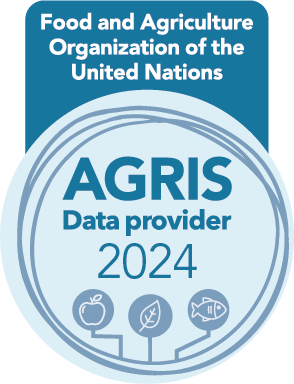Temporal and weather impacts on the rock bee, Apis dorsata Fab.(Hymenoptera, Apidae) visitations in urban green spaces in Bengaluru, India
DOI:
https://doi.org/10.24154/jhs.v19i2.3057Keywords:
Abiotic factors, Apis dorsata, urban gardensAbstract
Bengaluru, acclaimed as the Garden City of India, is an agglomerate of continuous development, and metropolitan gardens serve as a refuge for insect pollinators. These ecological green spaces are subject to the influence of weather and anthropogenic activity. To understand the impact of abiotic factors on the rock bee, Apis dorsata Fab, a study was carried out from 2014 to 2018 in two urban gardens, and the visitation of wild honey bees on flowers was correlated with abiotic factors as well as species of flora. The study showed temperature had a positive correlation (R² = 0.55 in site 1 and R² = 0.45 in site 2) to bee visits, while relative humidity and rain had a negative correlation (R² = 0.50 and R² = 0.50) in site 1. Pooled analysis of visitation on flowers showed that Jacquemontia pentanthos had the highest mean visits (1.7 insects/m²/2 minutes), followed by Hamelia patens (1.4 insects/m²/2 minutes) in site 1. In study site 2, Plumbago lanceolata had the highest mean visits (0.9 insects/m²/2 minutes), and Hibiscus species showed a mean of 0.6 insects/m²/2 minutes in the analysis from 2014–2018.
Downloads
References
Abrol, D. P. (2006). Diversity of pollinating insects visiting litchi flowers (Litchi chinensis Sonn.) and path analysis of environmental factors influencing foraging behaviour of four honeybee species. Journal of Apicultural Research, 45(4), 180-187.
https://doi.org/10.1080/00218839.2006.11101345
Ali, M., Sajjad, A., & Saeed, S. (2017). Yearlong association of Apis dorsata and Apis florea with flowering plants: Planted forest vs. agricultural landscape. Sociobiology, 64, 18-25.
https://doi.org/10.13102/sociobiology.v64i1.995
Baldock, K. C. R., et al. (2015). Where is the UK's pollinator biodiversity? The importance of urban areas for flower-visiting insects. Proceedings of the Royal Society B: Biological Sciences, 282, 20142849. https://doi.org/10.1098/rspb.2014.2849
https://doi.org/10.1098/rspb.2014.2849
Cui, Q., & Corlett, R. T. (2016). Seasonal and diurnal patterns of activity in honeybees (Apis spp.) on the northern edge of the Asian tropics; their implications for the climate-change resilience of pollination. Tropical Conservation Science, 1-9.
https://doi.org/10.1177/1940082916667142
Daniels, B., Jedamski, J., Ottermanns, R., & Ross-Nickoll, M. (2020). A "plan bee" for cities: Pollinator diversity and plant-pollinator interactions in urban green spaces. PLoS ONE, 15(7), e0235492.
https://doi.org/10.1371/journal.pone.0235492
Deguines, N., Julliard, R., de Flores, M., & Fontaine, C. (2012). The whereabouts of flower visitors: Contrasting land-use preferences revealed by a country-wide survey based on citizen science. PLoS ONE, 7(9), e45822. https://doi.org/10.1371/journal.pone.0045822
https://doi.org/10.1371/journal.pone.0045822
Hennessy, G., Harris, C., Eaton, C., Wright, P., Jackson, E., Goulson, D., & Ratnieks, F. F. L. W. (2020). Gone with the wind: Effects of wind on honey bee visit rate and foraging behavior. Animal Behaviour, 161, 23-31.
https://doi.org/10.1016/j.anbehav.2019.12.018
Hwang, J. H., Yim, M. Y., Kim, S. Y., Ji, S. J., & Lee, W. H. (2022). Sweep sampling comparison of terrestrial insect communities associated with herbaceous stratum in the riparian zone of the Miho River, Korea. Insects, 13(6), 497. https://doi.org/10.3390/insects13060497
https://doi.org/10.3390/insects13060497
Jayanthi, H., Husak, G. J., Funk, C., Magadzire, T., Adoum, A., & Verdin, J. P. (2014). A probabilistic approach to assess agricultural drought risk to maize in Southern Africa and millet in Western Sahel using satellite-estimated rainfall. International Journal of Disaster Risk Reduction, 10, 490-502. https://doi.org/10.1016/j.ijdrr.2014.04.002
https://doi.org/10.1016/j.ijdrr.2014.04.002
Ollerton, J., Winfree, R., & Tarrant, S. (2011). How many flowering plants are pollinated by animals? Oikos, 120, 321-326. https://doi.org/10.1111/j.1600-0706.2010.18644.x
https://doi.org/10.1111/j.1600-0706.2010.18644.x
Polatto, P., Chaud-Netto, J., & Alves, V. V. Junior. (2014). Influence of abiotic factors and floral resource availability on daily foraging activity of bees. Journal of Insect Behaviour. https://doi.org/10.1007/s10905-014-9452-6
https://doi.org/10.1007/s10905-014-9452-6
Potts, S. G., Biesmeijer, J. C., Kremen, C., Neumann, P., Schweiger, O., & Kunin, W. E. (2010). Global pollinator declines: Trends, impacts and drivers. Trends in Ecology & Evolution, 25(6), 345-353.
https://doi.org/10.1016/j.tree.2010.01.007
Robinson, W. S. (2012). Migrating giant honey bees (Apis dorsata) congregate annually at stopover site in Thailand. PLoS ONE, 7(9), e44976. https://doi.org/10.1371/journal.pone.0044976
https://doi.org/10.1371/journal.pone.0044976
Sandilyan, S. (2014). Decline of honey bee population in southern India: Role of disposable paper cups. Journal of Zoological and Bioscience Research, 1, 6-9.
Sihag, R. C. (2014). Phenology of migration and decline in colony numbers and crop hosts of giant honeybee (Apis dorsata F.) in semiarid environment of northwest India. Journal of Insects. https://doi.org/10.1155/2014/639467
https://doi.org/10.1155/2014/639467
Somanathan, H., Kelber, A., Borges, R. M., Wallén, R., & Warrant, E. J. (2009). Visual ecology of Indian carpenter bees II: Adaptations of eyes and ocelli to nocturnal and diurnal lifestyles. Journal of Comparative Physiology A, 195, 571-583.
https://doi.org/10.1007/s00359-009-0432-9
Southwood, T. R. E. (1978). Ecological methods, with particular reference to the study of insect populations. The English Language Book Society and Chapman & Hall, London.
https://doi.org/10.1007/978-94-015-7291-0
Vicens, N., & Bosch, J. (2000). Weather-dependent pollinator activity in an apple orchard, with special reference to Osmia cornuta and Apis mellifera (Hymenoptera: Megachilidae and Apidae). Environmental Entomology, 29(3), 413-420.
https://doi.org/10.1603/0046-225X-29.3.413
Young, A., Kodabalagi, S., Brockmann, A., & Dyer, F. (2021). A hard day's night: Patterns in the diurnal and nocturnal foraging behavior of Apis dorsata across lunar cycles and seasons. PLoS ONE. https://doi.org/10.1371/journal.pone.0258604
Downloads
Published
Issue
Section
License
Copyright (c) 2024 Anitha Abraham, Abraham Verghese, Mathews Raj, Rashmi Gowda, H Malathi (Author)

This work is licensed under a Creative Commons Attribution-NonCommercial-ShareAlike 4.0 International License.
Authors retain copyright. Articles published are made available as open access articles, distributed under the terms of the Creative Commons Attribution-NonCommercial-ShareAlike 4.0 International License, which permits unrestricted non-commercial use, distribution, and reproduction in any medium, provided the original author and source are credited. 
This journal permits and encourages authors to share their submitted versions (preprints), accepted versions (postprints) and/or published versions (publisher versions) freely under the CC BY-NC-SA 4.0 license while providing bibliographic details that credit, if applicable.











 .
. 













